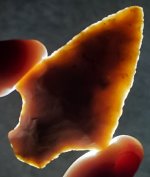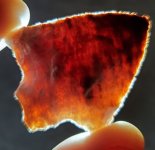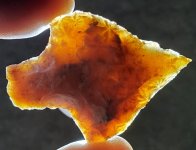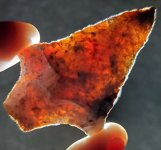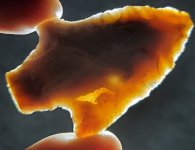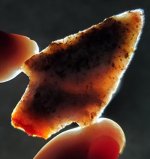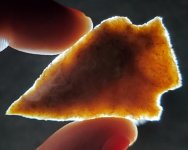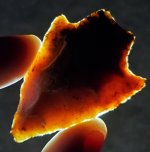Navigation
Install the app
How to install the app on iOS
Follow along with the video below to see how to install our site as a web app on your home screen.
Note: This feature may not be available in some browsers.
More options
You are using an out of date browser. It may not display this or other websites correctly.
You should upgrade or use an alternative browser.
You should upgrade or use an alternative browser.
Hit The Lights
- Thread starter antmike915
- Start date
Fat
Bronze Member
- Oct 22, 2020
- 2,191
- 6,888
- Detector(s) used
- I took the battery out because I like my bacon crispy
- Primary Interest:
- Other
...To me, this looks like a broken point reworked into a spokeshave..View attachment 1948450View attachment 1948451View attachment 1948452
Here?s a few more shots of it. Glad it?s getting some appreciation. Maybe you can see my dilemma in not being certain it didn?t turn out this way originally as opposed to the far more common line of thinking that it was reworked.
Amazon Forum Fav 👍
Fat
Bronze Member
- Oct 22, 2020
- 2,191
- 6,888
- Detector(s) used
- I took the battery out because I like my bacon crispy
- Primary Interest:
- Other
...I just looked up Stockton mounds archeology report 1923 and kinda once over speed read/red it.
... bones of deer, elk, sheep, duck, wild goose and rabbit were noted. I stopped when they were digging human bones..
... bones of deer, elk, sheep, duck, wild goose and rabbit were noted. I stopped when they were digging human bones..
antmike915
Silver Member
- Thread starter
- #43
...To me, this looks like a broken point reworked into a spokeshave..
I was thinking the same or possible drill.
MAMucker
Bronze Member
Mucker, Fat has a point, especially where we see the larger Stockton?s that can run between 2-3 inches. The point would pierce very effectively and then as the arrow(these were used at the advent of the bow and arrow, so they are post atlatl/dart) would move in all manner of direction, the serrations would be causing catastrophic damage to blood vessels and tissue etc. Stockton?s have also been said to develop during a time of warfare/territory skirmishes between groups in and near the distribution area of the point, but it?s just a likely it was developed as an effective hunter instrument correlating with an increase in large fauna hunting like deer and elk and so on. The smaller little birdies(quote un quote) in the cluster could?ve been for spearing fish and certainly for smaller game. The skill level and experience with obsidian had reached a high point and it?s been said that Stockton?s were manufactured by specialist knappers for trade.
Added: They were also said to have been used as saws and I have a few with blunted tips that seem like they made good little cutters.
Thanks for that follow up. A lot of good info there. No doubt the ancients were specialist with obsidian. And a wide range of amazing artifacts were made from obsidian.
But I have learned that the size of the point is not always relative to the size of the game. This has been demonstrated thoroughly by modern primitive hunters and in the inspection of the bones of the large animals that were killed. The Birdie tag has always bothered me. That?s just me.
Great information from your personal observations and personal finds. I have heard that pronounced serrations on blades are sometimes an indication of a saw type tooling purpose.
But the accentuated thick and deep serrations on a tiny arrowhead argues itself against it being an effective saw. This is where size matters I think.
There are a lot of these deeply serrated obsidian points found out west. We don?t find anything like them here. I?m always intrigued by them.
Sorry to take this down a rabbit hole antmike915
Last edited:
antmike915
Silver Member
- Thread starter
- #45
Thanks for that follow up. A lot of good info there. No doubt the ancients were specialist with obsidian. And a wide range of amazing artifacts were made from obsidian.
But I have learned that the size of the point is not always relative to the size of the game. This has been demonstrated thoroughly by modern primitive hunters and in the inspection of the bones of the large animals that were killed. The Birdie tag has always bothered me. That?s just me.
Great information from your personal observations and personal finds. I have heard that pronounced serrations on blades are sometimes an indication of a saw type tooling purpose.
But the accentuated thick and deep serrations on a tiny arrowhead argues itself against it being an effective saw. This is where size matters I think.
There are a lot of these deeply serrated obsidian points found out west. We don?t find anything like them here. I?m always intrigued by them.
Sorry to take this down a rabbit hole antmike915
The artifact rabbit hole
 so many theories; so much discussions. We don't have obsidian down south here either. Always appreciate your comments MA.
so many theories; so much discussions. We don't have obsidian down south here either. Always appreciate your comments MA.Top Member Reactions
-
 3448
3448 -
 1965
1965 -
 1908
1908 -
 1148
1148 -
 1089
1089 -
 1006
1006 -
 876
876 -
 861
861 -
 860
860 -
 776
776 -
 757
757 -
 676
676 -
 653
653 -
 567
567 -
 504
504 -
 451
451 -
 447
447 -
 410
410 -
 403
403 -
E
398
Users who are viewing this thread
Total: 3 (members: 0, guests: 3)
